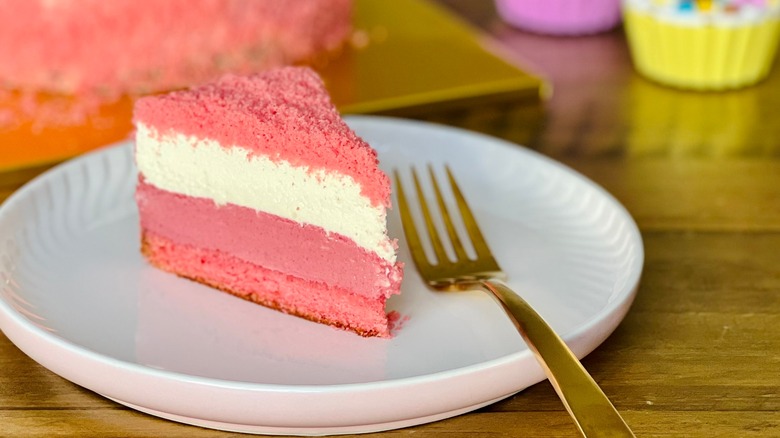What, Exactly, Is Pink Velvet Cake?
There are few desserts more mesmerizing to look at than a fluffy red velvet cake covered in decadent cream cheese frosting. Unveil one of these at a birthday party, and you're guaranteed to have a crowd-pleaser. But have you ever seen a pink velvet cake recipe and wondered what, exactly, it is? If you guessed a pink version of the beloved red velvet, you'd be right — kind of.
Pink velvet cake contains many of the same ingredients found in a classic red velvet cake recipe, including flour, sugar, eggs, buttermilk, and baking soda. But, there are some key differences. Pink velvet cake gets its pastel hue one of two ways: the addition of pink food coloring (as opposed to red), or by folding in pureed strawberries or raspberries into the frosting and sponge (as opposed to beetroot featured in some red velvet cakes). Additionally, pink velvet cakes don't always include cocoa powder like red velvet cakes do.
Those who love the flavor of chocolate can certainly add cocoa to pink velvet cake, but it might mess with the appearance. The light color of pink velvet cake primes the eater's mind for flavors more on the fruit and vanilla spectrum, compared to the deeper and chocolaty notes signature to red velvet. With pink velvet cakes that omit the cocoa powder, sharp and tangy cream cheese frosting is no longer a necessary component. Instead, the cake allows bakers to experiment with lighter complimentary flavors like compotes and whipped cream.
The history of velvet cakes
Because it is a relatively young iteration of its famous counterpart, the history of pink velvet cake is undeniably tied to the history of red velvet cake. The story of the red velvet cake's rise in popularity starts in the early 20th century, with bakers adding one of its key ingredients: cocoa powder. Natural cocoa powder has a fairly acidic pH of about five, as well as flavor compounds called anthocyanins. When cocoa reacts with other acidic ingredients in red velvet cake, like buttermilk and vinegar, a natural reddening of the baked sponges occurs.
But by the 1940s, war-rationing made cocoa powder a scarce commodity. As a result, beet juice or grated beetroot started being used to lend a more intense red color to cakes, and thus, the iconic deep tone of red velvet cake was born. The recipe continued to evolve into what we know it as today, reaching its zenith in the 1960s, by which time red food coloring was being use to make the dessert.
Fast-forward to today, baking creativity has boomed in the age of the internet. This has led to the development of variations on old classics, including the birth of pink velvet cake. While there is no definitive year that marks the start of pink velvet cake, it's safe to say that it started becoming more popular in the 2010s, judging by how many recipes can be found dated during the past decade.
Variations on pink velvet cake
Pink velvet cake is a visually appealing dessert that can add a sense of celebration to any occasion, making it a perfect vehicle for trying many variations. It's great as a traditional sponge cake, but if you can make that, you can also make pink velvet cupcakes frosted with buttercream. And if you're really ambitious, you can even turn leftover pink velvet cupcakes into cake pops. These single-serving showstoppers, like cupcakes, are the perfect way to add pink flair to any baby shower.
Another variation on pink velvet cake that you might encounter is pink velvet cheesecake. Like classic New York cheesecake, velvet cakes feature tangy flavors in the forms of buttermilk in the sponge and cream cheese in the frosting. This makes pink velvet cake an easy concept to execute in cheesecake form. Additionally, those who like the cocoa flavors of velvet cake can also adapt the concept to make pink velvet brownies. You could try this at home by subbing strawberry cake batter for the usual brownie mix and adding a bit of cocoa powder and pink food coloring. Pink velvet cake and brownies work well with rich or delicate frostings — so, get creative with the decorations and enjoy!


